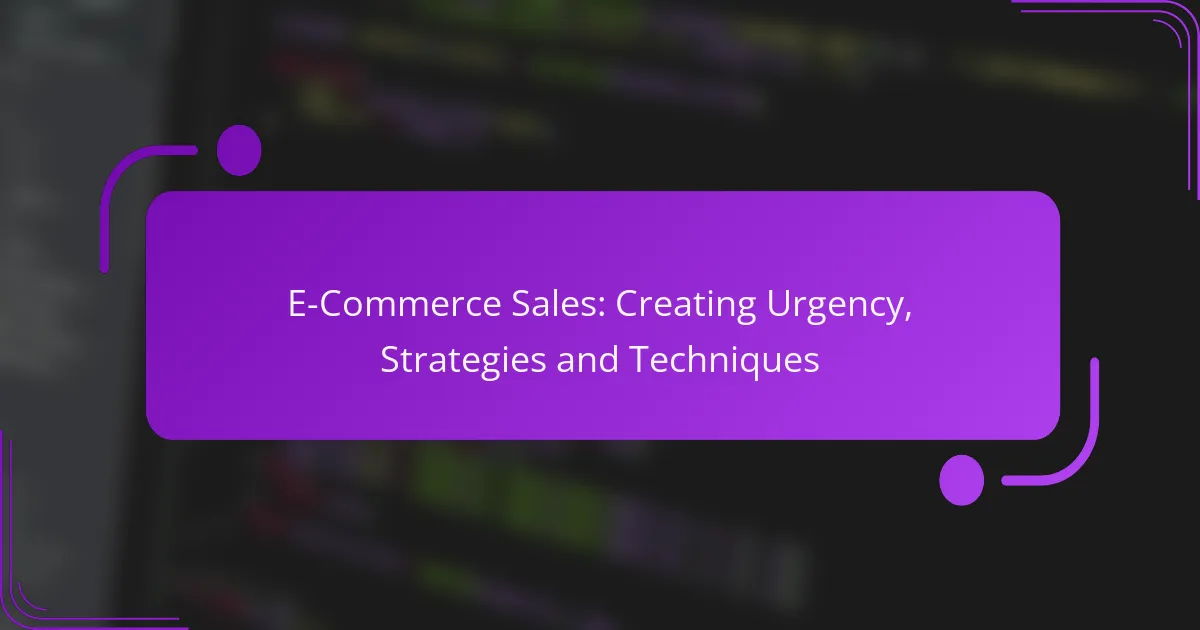Creating urgency in e-commerce sales is essential for driving quick purchasing decisions and boosting conversion rates. By utilizing time-sensitive offers and highlighting limited availability, businesses can effectively prompt customers to act swiftly. Implementing strategies such as countdown timers, low-stock alerts, and personalized promotions can significantly enhance the shopping experience and foster customer loyalty.
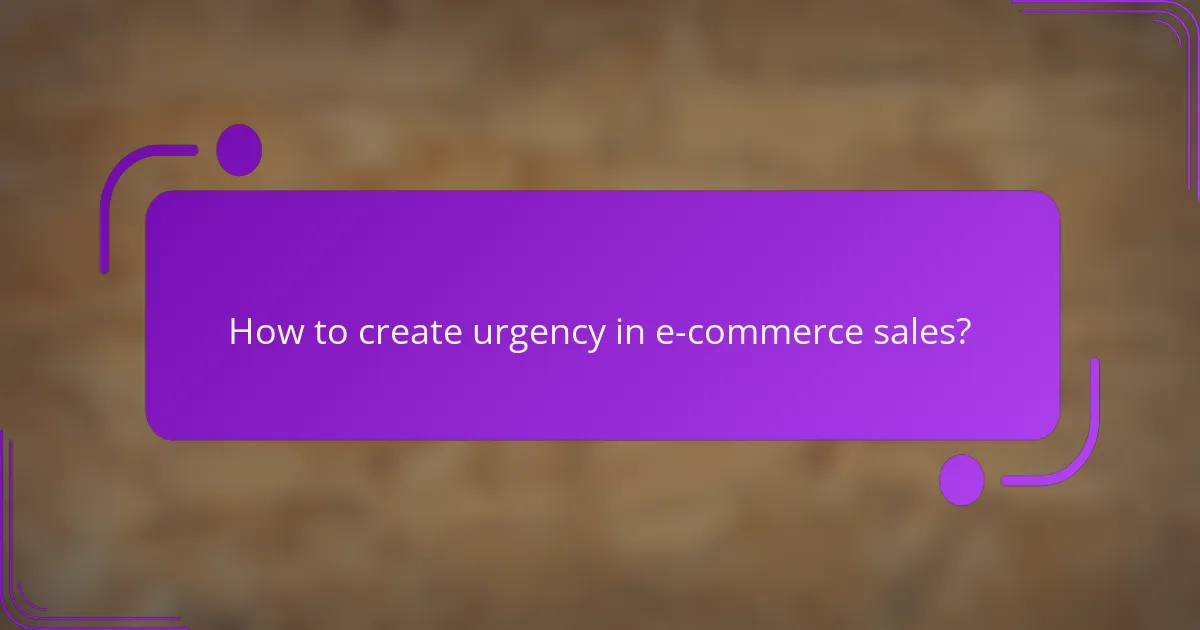
How to create urgency in e-commerce sales?
Creating urgency in e-commerce sales involves implementing strategies that encourage customers to make quick purchasing decisions. By leveraging time-sensitive offers and limited availability, businesses can drive immediate action and increase conversion rates.
Limited-time offers
Limited-time offers create a sense of urgency by providing discounts or promotions that expire within a specific timeframe. This tactic can motivate customers to buy before missing out on a deal. For instance, a retailer might offer a 20% discount on select items for just 48 hours.
To maximize effectiveness, clearly communicate the end date of the offer and consider using eye-catching graphics to highlight the promotion. Be cautious not to overuse this tactic, as frequent limited-time offers may reduce their perceived value.
Scarcity tactics
Scarcity tactics involve highlighting the limited availability of products to encourage quick purchases. Phrases like “Only 3 left in stock!” can trigger a fear of missing out (FOMO) among potential buyers. This approach works well for high-demand items or seasonal products.
However, ensure that the scarcity is genuine to maintain customer trust. Misleading customers about stock levels can lead to negative reviews and damage your brand’s reputation.
Countdown timers
Countdown timers visually display the time remaining for a deal, enhancing the urgency to act quickly. These timers can be placed on product pages or during checkout to remind customers of the impending deadline. For example, a timer showing “Sale ends in 2 hours, 15 minutes” can effectively prompt immediate action.
When using countdown timers, make sure they are accurate and reset appropriately after the offer ends. This transparency helps build trust and encourages repeat business.
Flash sales
Flash sales are short-term sales events that typically last for a few hours to a day, offering significant discounts on select items. These events create excitement and urgency, prompting customers to act fast to secure the best deals. For example, a flash sale might feature 50% off on a popular product for just 6 hours.
To promote flash sales effectively, utilize email marketing and social media to alert your audience. Ensure that your website can handle increased traffic during these events to avoid potential technical issues.
Exclusive deals
Exclusive deals, such as member-only discounts or early access to sales, can create a sense of urgency among loyal customers. By offering special promotions to a select group, you encourage immediate purchases while fostering customer loyalty. An example could be a 30% discount for newsletter subscribers available for one day only.
To implement this strategy, clearly communicate the exclusivity of the offer and consider using personalized messaging. This approach not only drives urgency but also enhances customer engagement and retention.

What strategies boost e-commerce sales?
Effective strategies to boost e-commerce sales focus on creating urgency, enhancing customer experience, and leveraging social influence. Implementing techniques such as personalization, social proof, targeted email campaigns, and influencer partnerships can significantly increase conversion rates and customer loyalty.
Personalization techniques
Personalization techniques involve tailoring the shopping experience to individual customers based on their preferences and behaviors. This can include personalized product recommendations, customized landing pages, and targeted promotions that resonate with specific user segments.
To implement personalization, use data analytics to track customer interactions and preferences. For example, displaying recently viewed items or suggesting complementary products can encourage additional purchases. Aim for a balance between personalization and privacy to maintain customer trust.
Social proof integration
Social proof integration leverages the influence of others to build trust and encourage purchases. This can be achieved through customer reviews, testimonials, and user-generated content displayed prominently on product pages.
Consider showcasing ratings and reviews from verified buyers to enhance credibility. Additionally, displaying the number of items sold or highlighting popular products can create a sense of urgency and encourage potential buyers to act quickly.
Targeted email campaigns
Targeted email campaigns involve sending tailored messages to specific customer segments based on their behavior and preferences. This strategy can effectively re-engage past customers, promote new products, or offer exclusive discounts.
To maximize effectiveness, segment your email list by factors such as purchase history or browsing behavior. Use compelling subject lines and clear calls to action to drive engagement. Regularly analyze campaign performance to refine your approach and improve results.
Influencer partnerships
Influencer partnerships can amplify your brand’s reach and credibility by leveraging the trust that influencers have built with their audiences. Collaborating with influencers who align with your brand values can drive traffic and increase sales.
When selecting influencers, consider their audience demographics and engagement rates. Micro-influencers, who typically have smaller but highly engaged followings, can be particularly effective for niche markets. Ensure that the partnership feels authentic to resonate well with potential customers.
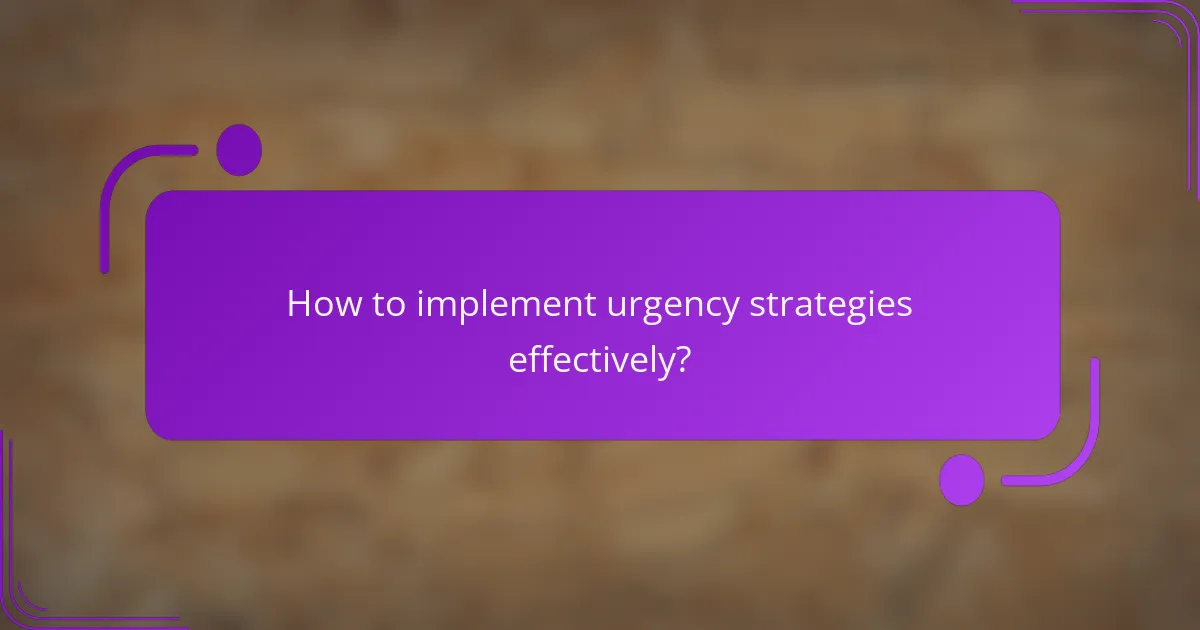
How to implement urgency strategies effectively?
To implement urgency strategies effectively, focus on creating a sense of immediate action among your customers. This can be achieved through limited-time offers, countdown timers, or low-stock alerts that encourage quick decision-making.
Identify target audience
Understanding your target audience is crucial for implementing urgency strategies. Different demographics respond to urgency in various ways; for instance, younger consumers may react more positively to flash sales, while older customers might prefer clear communication about limited availability.
Conduct market research to pinpoint preferences and behaviors. Surveys and social media insights can help you tailor your urgency tactics to resonate with your audience, ensuring higher engagement and conversion rates.
Test different approaches
Testing various urgency tactics is essential to find what works best for your business. Experiment with different messaging, such as “Only 3 left!” versus “Sale ends in 24 hours!” to see which prompts more purchases.
Use A/B testing to compare the effectiveness of these strategies. Track metrics like click-through rates and conversion rates to determine which approach generates the most urgency and sales.
Analyze customer behavior
Analyzing customer behavior can provide insights into how urgency strategies impact purchasing decisions. Utilize analytics tools to monitor how customers interact with your urgency messages, such as whether they respond better to time-sensitive offers or stock alerts.
Look for patterns in buying habits. For example, if you notice that urgency tactics lead to increased sales during specific times or events, you can optimize your marketing strategies accordingly to capitalize on these trends.
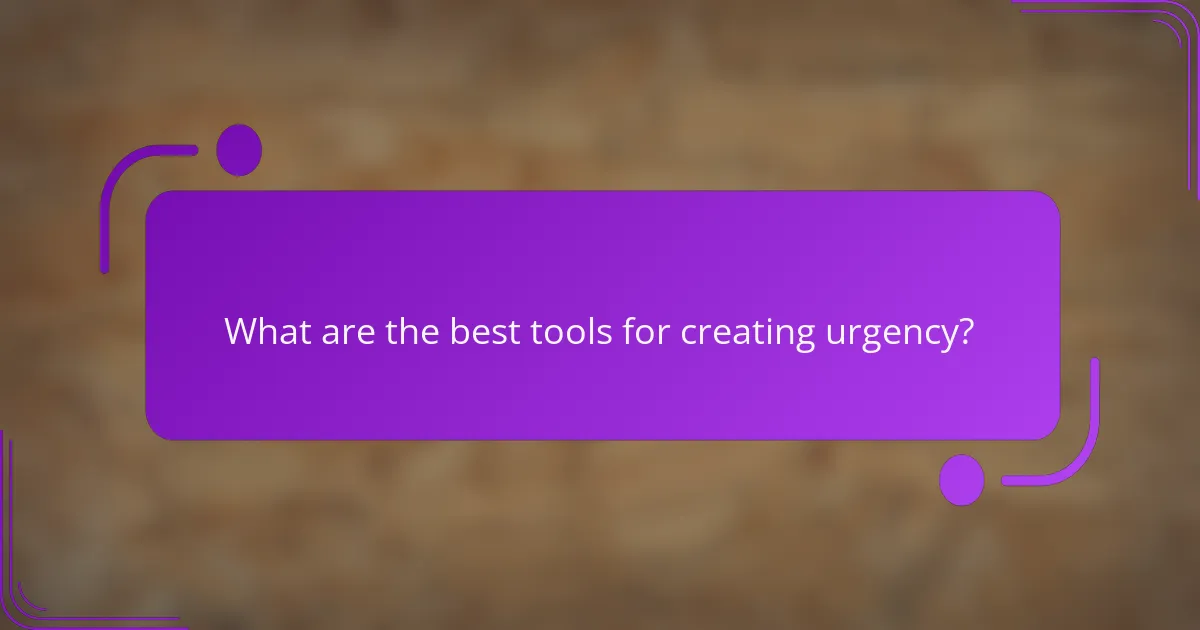
What are the best tools for creating urgency?
Effective tools for creating urgency in e-commerce include various apps and plugins designed to encourage quick purchasing decisions. These tools leverage psychological triggers, such as limited-time offers and scarcity, to motivate customers to act swiftly.
Shopify apps
Shopify offers a range of apps specifically designed to create urgency. Popular options include “Scarcity: Countdown Timer” and “Hurry: Limited Time Offers,” which allow merchants to display countdowns and low-stock alerts directly on product pages. These apps can significantly enhance customer engagement and drive sales.
When selecting a Shopify app, consider factors like user reviews, ease of integration, and pricing. Many apps offer free trials, allowing you to test their effectiveness before committing to a subscription.
Countdown timer plugins
Countdown timer plugins are effective for creating a sense of urgency by visually displaying the time remaining for a promotion. These plugins can be integrated into websites or landing pages to highlight flash sales or limited-time discounts. Examples include “Countdown Timer by POWr” and “Countdown Timer Ultimate.”
Ensure that the countdown timer is prominently placed and visually appealing. A well-designed timer can increase conversion rates by reminding customers that time is running out, prompting them to complete their purchases sooner.
Email marketing platforms
Email marketing platforms like Mailchimp and Klaviyo can effectively create urgency through targeted campaigns. By sending time-sensitive offers or reminders about limited stock, you can encourage recipients to act quickly. Segmenting your audience allows for personalized messages that resonate more with specific customer groups.
When using email to create urgency, include clear calls to action and visually appealing designs. A/B testing different subject lines and content can help identify what resonates best with your audience, maximizing the effectiveness of your urgency-driven campaigns.
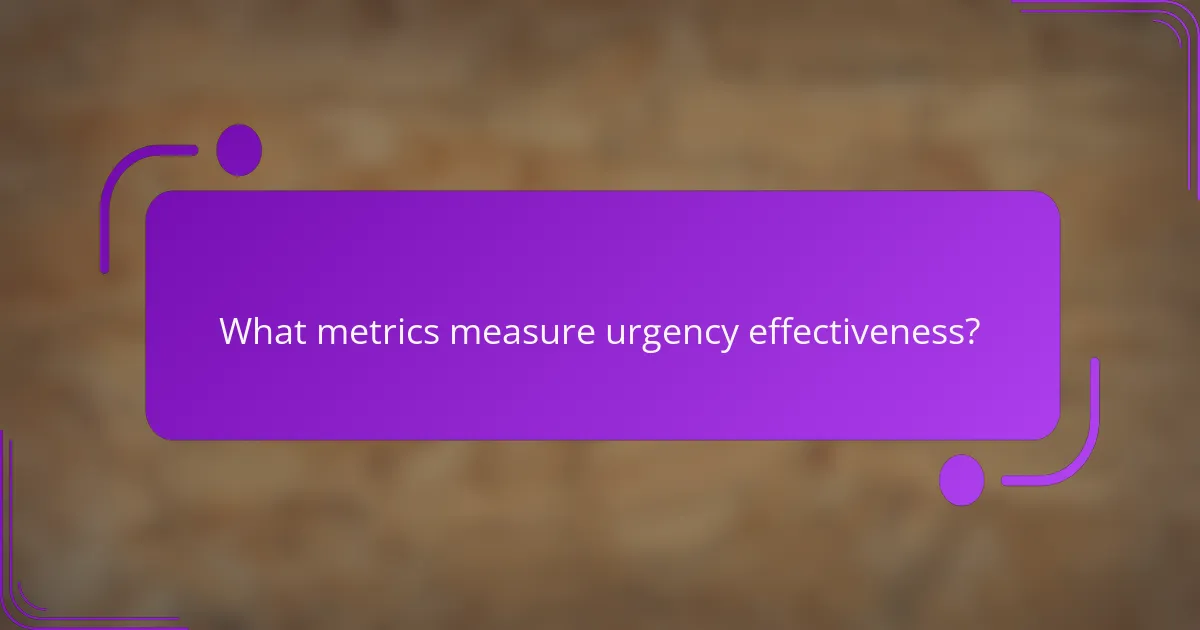
What metrics measure urgency effectiveness?
To gauge the effectiveness of urgency in e-commerce sales, key metrics include conversion rates, click-through rates, and average order value. These metrics provide insights into how urgency influences customer behavior and purchasing decisions.
Conversion rates
Conversion rates indicate the percentage of visitors who make a purchase after engaging with urgency tactics, such as limited-time offers or countdown timers. A well-executed urgency strategy can lead to conversion rates increasing by several percentage points, particularly during promotional events.
To improve conversion rates, consider using clear calls to action and emphasizing scarcity. For instance, displaying a message like “Only 3 left in stock!” can prompt quicker purchasing decisions. Monitor these rates regularly to assess the impact of your urgency strategies.
Click-through rates
Click-through rates measure how often users click on urgency-driven content, such as promotional banners or emails. Higher click-through rates suggest that urgency tactics effectively capture attention and encourage engagement. Aim for click-through rates in the low to mid double digits for successful campaigns.
To enhance click-through rates, use compelling visuals and concise messaging that highlight urgency. Phrases like “Sale ends soon!” can create a sense of immediacy. A/B testing different approaches can help identify the most effective strategies for your audience.
Average order value
Average order value (AOV) reflects the average amount spent per transaction and can be influenced by urgency tactics. By creating limited-time offers that encourage customers to add more items to their cart, you can increase AOV. AOV increases of 10-20% are not uncommon with effective urgency strategies.
To boost AOV, consider implementing tiered discounts, such as “Spend $50 and get 20% off.” This encourages customers to purchase additional items to reach the discount threshold. Regularly analyze AOV alongside urgency campaigns to optimize your approach.
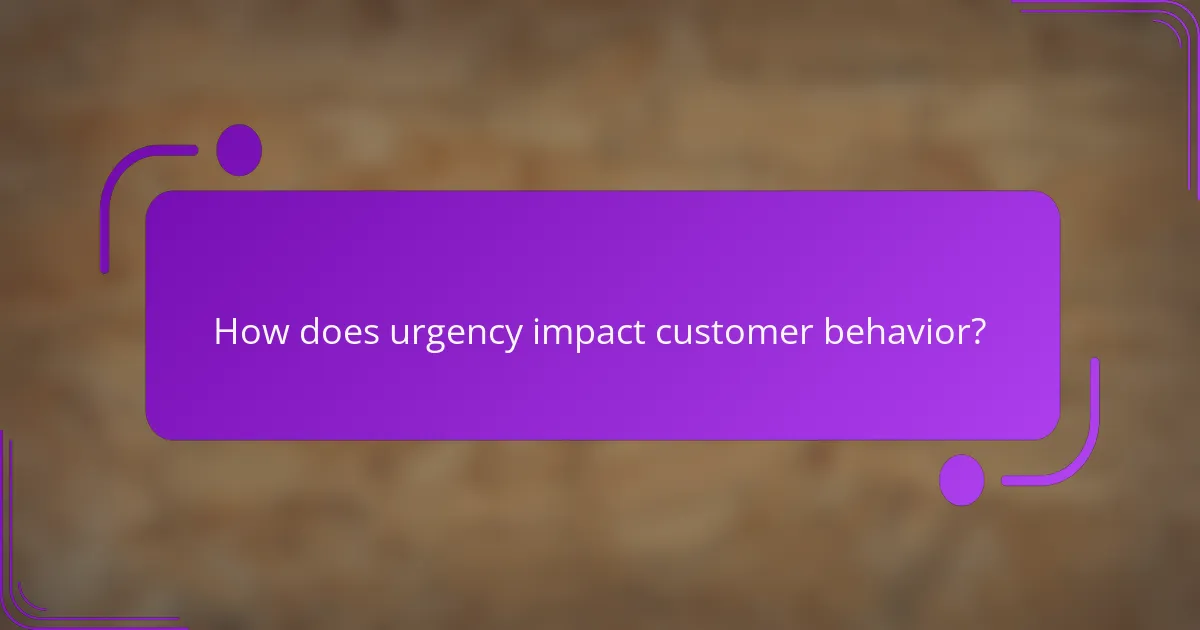
How does urgency impact customer behavior?
Urgency significantly influences customer behavior by prompting quicker purchasing decisions. When customers perceive a limited time offer or scarcity, they are more likely to act swiftly to avoid missing out.
Creating a Sense of Urgency
To create a sense of urgency, businesses can employ tactics such as limited-time discounts, countdown timers, or highlighting low stock levels. These strategies encourage customers to make faster decisions, as they feel the pressure of potentially losing a deal.
For example, an online retailer might display a banner stating “Only 3 items left!” or “Sale ends in 2 hours!” to instill urgency. This can lead to increased conversion rates as customers rush to complete their purchases.
Psychological Triggers
Urgency leverages psychological triggers such as fear of missing out (FOMO) and scarcity. When customers believe that an offer is time-sensitive or that a product is in limited supply, they may prioritize that purchase over others.
Using phrases like “Last chance” or “Limited edition” can enhance this effect, making customers feel that they must act immediately to secure the item. This tactic can be particularly effective during seasonal sales or promotional events.
Best Practices for Implementing Urgency
Implementing urgency effectively requires a balance to avoid overwhelming customers. Clear communication about the terms of urgency, such as specific time limits or stock quantities, is essential.
Consider using countdown timers on product pages to visually reinforce urgency. Additionally, ensure that any claims about scarcity are genuine to maintain trust with your customers. Misleading tactics can lead to backlash and damage your brand’s reputation.
Common Mistakes to Avoid
One common mistake is overusing urgency tactics, which can desensitize customers and reduce their effectiveness. If customers frequently encounter false urgency, they may become skeptical and less likely to respond.
Another pitfall is failing to provide a clear call to action. Ensure that your urgency messaging is accompanied by straightforward instructions on how to take advantage of the offer, such as “Shop Now” or “Add to Cart.” This clarity can significantly enhance the likelihood of conversion.
